This week offers the last of the DC Convergence titles — which would mean less work for me next week, except that now all the Secret Wars tie-ins are in full bloom. Otherwise, there’s new work by Neil Gaiman, Walt Simonson and Alan Moore, plus a few other books. Let’s see:
 Convergence #8 — Writers: Jeff King and Scott Lobdell; Pencils: Stephen Segovia, Carlo Pagulayan, Eduardo Pansica and Ethan Van Sciver; Inks: Five different guys; Colors: Peter Steigerwald
Convergence #8 — Writers: Jeff King and Scott Lobdell; Pencils: Stephen Segovia, Carlo Pagulayan, Eduardo Pansica and Ethan Van Sciver; Inks: Five different guys; Colors: Peter Steigerwald
Convergence: Action Comics #2 (of 2) — Writer: Justin Gray; Pencils: Claude St-Aubin; Inks: Sean Parsons; Colors: Lovern Kindzierski and Hi-Fi
Convergence: Detective Comics #2 (of 2) — Writer: Len Wein; Art: Denys Cowan and Bill Sienkiewicz; Colors: Chris Sotomayor
 Convergence: Infinity Inc. #2 (of 2) — Writer: Jerry Ordway; Layouts: Ben Caldwell; Pencils: June Brigman; Inks: Roy Richardson; Colors: Veronica Gandini
Convergence: Infinity Inc. #2 (of 2) — Writer: Jerry Ordway; Layouts: Ben Caldwell; Pencils: June Brigman; Inks: Roy Richardson; Colors: Veronica Gandini
Convergence: Justice Society of America #2 (of 2) — Writer: Dan Abnett; Pencils: Tom Derenick; Inks: Trevor Scott; Colors: Monica Kubina
Convergence itself ends about as it began: as predicted, there’s no major resetting of the DC Universe, with almost everyone back in their original timelines/dimensions; however, there are a couple of exceptions that I’ll leave readers to find, including an interesting possible retcon of 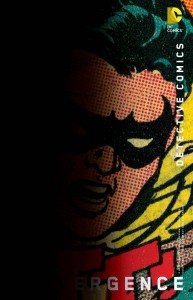 Crisis on Infinite Earths, a dangling plotline that’s sure to be another event at some later date. Also, the Earth-2 characters end up in moderately-different circumstances (but still in their own universe, so they won’t be interacting with “our” DC characters that much) and are set up for their new series starting in June. The art-by-committee approach — four different pencillers, and five different inkers — makes the visuals uneven, although some individual panels and pages are very good-looking, but considering that this started out just as a way for the creators on the regular books to get two months off (as DC moved its corporate offices from NY to LA), its cheerful throw-everything-in-the-pot approach has worked rather well. Unlike the last three weeks, not all of the tie-ins feature characters from the same timeline, although this first group all uses the Justice Society/Earth-2 characters
Crisis on Infinite Earths, a dangling plotline that’s sure to be another event at some later date. Also, the Earth-2 characters end up in moderately-different circumstances (but still in their own universe, so they won’t be interacting with “our” DC characters that much) and are set up for their new series starting in June. The art-by-committee approach — four different pencillers, and five different inkers — makes the visuals uneven, although some individual panels and pages are very good-looking, but considering that this started out just as a way for the creators on the regular books to get two months off (as DC moved its corporate offices from NY to LA), its cheerful throw-everything-in-the-pot approach has worked rather well. Unlike the last three weeks, not all of the tie-ins feature characters from the same timeline, although this first group all uses the Justice Society/Earth-2 characters 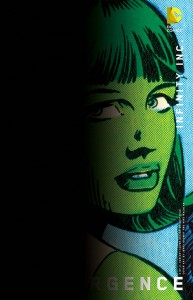 from just before Crisis on Infinite Earths (and each book still includes a different preview of one of DC’s June books). Action Comics, naturally, has the Golden Age Superman and his cousin Power Girl against the Red Son/Russian versions of Wonder Woman and Lex Luthor; it offers a preview of next month’s Sinestro, written by Cullen Bunn and with some nicely-detailed pencils by Brad Walker. Detective Comics stars the Earth-2 grown-up Robin and Huntress against the Red Son Superman (with that universe’s Batman making an appearance too), and is one of the better main stories, thanks to the Wein/Cowan/Sienkiewicz creative team; the preview is of the next Flash, written by Van Jenson and with art by Bret Booth and Norm Rapmund, and it looks to be introducing some new Rogue’s Gallery villains, and tracking closer to the TV show in its supporting cast and circumstances. Infinity Inc. has those second-generation JSAers against the
from just before Crisis on Infinite Earths (and each book still includes a different preview of one of DC’s June books). Action Comics, naturally, has the Golden Age Superman and his cousin Power Girl against the Red Son/Russian versions of Wonder Woman and Lex Luthor; it offers a preview of next month’s Sinestro, written by Cullen Bunn and with some nicely-detailed pencils by Brad Walker. Detective Comics stars the Earth-2 grown-up Robin and Huntress against the Red Son Superman (with that universe’s Batman making an appearance too), and is one of the better main stories, thanks to the Wein/Cowan/Sienkiewicz creative team; the preview is of the next Flash, written by Van Jenson and with art by Bret Booth and Norm Rapmund, and it looks to be introducing some new Rogue’s Gallery villains, and tracking closer to the TV show in its supporting cast and circumstances. Infinity Inc. has those second-generation JSAers against the 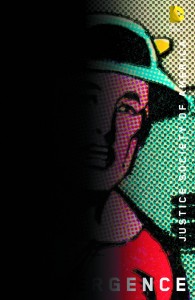 future/dystopian cast of Hex, which is not, frankly, that exciting, but the preview is of the recently-rebooted version of Batgirl, still written by Cameron Stewart and Brenden Fletcher, and with art by Babs Tarr; it’s been a high-quality and critically-acclaimed book, breezy and super-charming, as the self-contained eight-page story here demonstrates. Finally, Justice Society of America features… well, you can guess, as they power-up and get younger to fight the Weaponers of Qward and defend their city one last time. The preview is of Superman/Wonder Woman, using the vastly-depowered Superman from the other June books, and ends with a development that, if it isn’t a feint, will change their relationship considerably; it’s written by Peter Tomasi and with art from Paulo Siqueira.
future/dystopian cast of Hex, which is not, frankly, that exciting, but the preview is of the recently-rebooted version of Batgirl, still written by Cameron Stewart and Brenden Fletcher, and with art by Babs Tarr; it’s been a high-quality and critically-acclaimed book, breezy and super-charming, as the self-contained eight-page story here demonstrates. Finally, Justice Society of America features… well, you can guess, as they power-up and get younger to fight the Weaponers of Qward and defend their city one last time. The preview is of Superman/Wonder Woman, using the vastly-depowered Superman from the other June books, and ends with a development that, if it isn’t a feint, will change their relationship considerably; it’s written by Peter Tomasi and with art from Paulo Siqueira.
 Convergence: Blue Beetle #2 (of 2) — Writer: Scott Lobdell; Art: Yishan Li; Colors: Dave McCaig
Convergence: Blue Beetle #2 (of 2) — Writer: Scott Lobdell; Art: Yishan Li; Colors: Dave McCaig
Convergence: Booster Gold #2 (of 2) — Writer: Dan Jurgens; Pencils: Alvaro Martinez; Inks: Raul Fernandez; Colors: Chris Sotomayer and Sotocolor
Convergence: Crime Syndicate #2 (of 2) — Writer: Brian Buccellato; Art: Phil Winslade; Colors: Lovern Kindierski
Convergence: Plastic Man and the Freedom Fighters #2 (of 2) — Writer: Simon Oliver; Art: John McCrea; Colors:  John Kalisz
John Kalisz
Convergence: Shazam #2 (of 2) — Writer: Jeff Parker; Art: Ivan “Doc” Shaner; Colors: Jordie Bellaire
Convergence: World’s Finest #2 (of 2) — Writer: Paul Levitz; Pencillers: Jim Fern and Ron Wagner; Inkers: Joe Rubinstein, Wayne Faucher and Jose Marzan Jr.; Colors: Paul Mounts
These other six Convergence minis all feature different characters/cities; Blue Beetle has the ’60s Charleton heroes from Hub City — specifically, Beetle, The Question and  Captain Atom — and offers a just-tongue-in-cheek enough script and some interesting, manga-esque art. The preview is of the new Black Canary book, by Batgirl co-writer Brenden Fletcher and with art by Annie Wu, and it’s a smart, worthy companion to that title, whose many new fans should help to make it a hit. Booster Gold continues to be the closest tie-in to the main Convergence series, as Booster runs into the ’80s-era Blue Beetle, faces off against the Legion of Super-Heroes, and watches his much-older self transform into… well, another character, and a very logical one, all courtesy of his original creator Dan Jurgens. The preview is of the new Earth 2: Society, with those characters now on a new
Captain Atom — and offers a just-tongue-in-cheek enough script and some interesting, manga-esque art. The preview is of the new Black Canary book, by Batgirl co-writer Brenden Fletcher and with art by Annie Wu, and it’s a smart, worthy companion to that title, whose many new fans should help to make it a hit. Booster Gold continues to be the closest tie-in to the main Convergence series, as Booster runs into the ’80s-era Blue Beetle, faces off against the Legion of Super-Heroes, and watches his much-older self transform into… well, another character, and a very logical one, all courtesy of his original creator Dan Jurgens. The preview is of the new Earth 2: Society, with those characters now on a new  home, courtesy of the end of Convergence; it’s written by Daniel H. Wilson and has art by Jorge Jimenez. Crime Syndicate has the former Earth-3 reverse-heroes from Forever Evil against the far-future version of the JLA from the One Million series, and is helped by the good-looking Phil Winslade art; the preview is of Cyborg #1, with script by David Walker and art by Ivan Reis and Joe Prado, and looks to be beginning one of those “everything you thought you knew about this character is wrong” arcs. Plastic Man and the Freedom Fighters has those modern-era Nazi-resistance fighters (from a world where Germany won WW II) reluctantly teaming up with their foes to fight the Terminator-like human/machine
home, courtesy of the end of Convergence; it’s written by Daniel H. Wilson and has art by Jorge Jimenez. Crime Syndicate has the former Earth-3 reverse-heroes from Forever Evil against the far-future version of the JLA from the One Million series, and is helped by the good-looking Phil Winslade art; the preview is of Cyborg #1, with script by David Walker and art by Ivan Reis and Joe Prado, and looks to be beginning one of those “everything you thought you knew about this character is wrong” arcs. Plastic Man and the Freedom Fighters has those modern-era Nazi-resistance fighters (from a world where Germany won WW II) reluctantly teaming up with their foes to fight the Terminator-like human/machine  hybrids from Futures End, and has a preview of the new Harley Quinn — which, since it’s still written by Amanda Connor and Jimmy Palmiotti, and drawn by Chad Hardin, is pretty much exactly like the old Harley Quinn (not a bad thing, since it’s been one of DC’s most-recent hits). That leaves Shazam, with, first, Captain Marvel and the Fawcett heroes against the steampunk-era Batman from the Gotham by Gaslight Elseworlds book, and then everybody teaming up against the real threat: two of the recurring Fawcett villains who aren’t named “Sivana”; the just-cartoony enough art by Shaner and the gorgeous Bellaire coloring make this a very attractive comic. The preview is of the newest version of
hybrids from Futures End, and has a preview of the new Harley Quinn — which, since it’s still written by Amanda Connor and Jimmy Palmiotti, and drawn by Chad Hardin, is pretty much exactly like the old Harley Quinn (not a bad thing, since it’s been one of DC’s most-recent hits). That leaves Shazam, with, first, Captain Marvel and the Fawcett heroes against the steampunk-era Batman from the Gotham by Gaslight Elseworlds book, and then everybody teaming up against the real threat: two of the recurring Fawcett villains who aren’t named “Sivana”; the just-cartoony enough art by Shaner and the gorgeous Bellaire coloring make this a very attractive comic. The preview is of the newest version of  Constantine: The Hellblazer, and is noteworthy because it features art by the well-regarded indy artist Riley Rossmo (from Drumheller and, most recently, Rasputin), over a script by Ming Doyle and James Tynion IV; John C. hasn’t looked this good in a couple of years. Finally, World’s Finest has the Seven Soldiers of Victory against the Weaponers of Qward, courtesy of Paul Levitz, Jim Fern and Ron Wagner, and is a decent slice of Golden-Age fun; the preview is of We Are Robin, a kind of Batman Inc. for Damian now that Bruce Wayne has “died”; it’s written by Lee Bermejo and has art by Jorge Corona, and offers as good a place as any to end DC’s Convergence month.
Constantine: The Hellblazer, and is noteworthy because it features art by the well-regarded indy artist Riley Rossmo (from Drumheller and, most recently, Rasputin), over a script by Ming Doyle and James Tynion IV; John C. hasn’t looked this good in a couple of years. Finally, World’s Finest has the Seven Soldiers of Victory against the Weaponers of Qward, courtesy of Paul Levitz, Jim Fern and Ron Wagner, and is a decent slice of Golden-Age fun; the preview is of We Are Robin, a kind of Batman Inc. for Damian now that Bruce Wayne has “died”; it’s written by Lee Bermejo and has art by Jorge Corona, and offers as good a place as any to end DC’s Convergence month.
 Sandman: Overture #5 (of 6) — Writer: Neil Gaiman; Art: J.H. Williams III; Colors: Dave Stewart
Sandman: Overture #5 (of 6) — Writer: Neil Gaiman; Art: J.H. Williams III; Colors: Dave Stewart
This was the only other DC title I found worth mentioning, but the Gaiman/Williams III team is so dense in its storytelling pleasures, while managing both slick production and imaginative psychedelic layouts, that it couldn’t be ignored. It’s been wildly off-schedule, but it doesn’t really matter; this will be a collected story that, like all the other Sandman volumes, will be around forever, but it’s always a treat to see an installment fresh off the presses.
 Secret Wars: Inferno #1 — Writer: Dennis Hopeless; Art: Javier Garron; Colors: Chris Sotomayer
Secret Wars: Inferno #1 — Writer: Dennis Hopeless; Art: Javier Garron; Colors: Chris Sotomayer
Secret Wars: Infinity Gauntlet #1 — Writer: Gerry Duggan; Art/Colors: Dustin Weaver
Secret Wars: Inhumans: Attilan Rising #1 — Writer: Charles Soule; Pencils: John Timms; Inks: Roberto Poggi; Colors: Frank D’Armata
Secret Wars: M.O.D.O.K. Assassin #1 — Writer: Christopher Yost; Pencils: Amilcar Pinna; Inks: Amilcar  Pinna and Terry Pallot; Colors: Rachelle Rosenberg
Pinna and Terry Pallot; Colors: Rachelle Rosenberg
Secret Wars: Old Man Logan #1 — Writer: Brian Michael Bendis; Art: Andrea Sorrentino; Colors: Marcelo Maiolo
Secret Wars 2099 #1 — Writer: Peter David; Art: Will Sliney; Colors: Antonio Fabela and Andres Mossa
Secret Wars: Where Monsters Dwell #1 — Writer: Garth Ennis; Art: Russ Braun; Colors: Dono Sanchez Almara
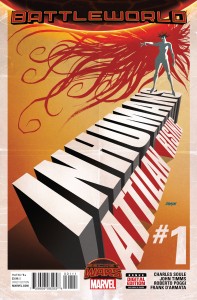 On to the Marvel Secret Wars tie-ins. For those of you who came in late: The entire Marvel multiverse is gone, destroyed in a cosmic — well, I was going to say “convergence,” but let’s go with “cataclysm” — and somehow the trio of Dr. Doom, Dr. Strange and the Molecule Man have been able to save bits of various timelines and dimensions and cobble them into a patchwork planet where an omnipotent Doom is worshiped as God, Dr. Strange is his sheriff/advisor, a whole bunch of Thors are the security force, and the Molecule Man is… hmmm, somewhere they haven’t revealed quite yet. Each of these mini-series will
On to the Marvel Secret Wars tie-ins. For those of you who came in late: The entire Marvel multiverse is gone, destroyed in a cosmic — well, I was going to say “convergence,” but let’s go with “cataclysm” — and somehow the trio of Dr. Doom, Dr. Strange and the Molecule Man have been able to save bits of various timelines and dimensions and cobble them into a patchwork planet where an omnipotent Doom is worshiped as God, Dr. Strange is his sheriff/advisor, a whole bunch of Thors are the security force, and the Molecule Man is… hmmm, somewhere they haven’t revealed quite yet. Each of these mini-series will  be, I think, five issues, and focuses on one section of the planet (called Battleworld, because, well, you know, conflict…), and group of characters from Marvel’s past. Case in point: Inferno is from that 1990’s-era X-Men crossover involving demons invading New York, except that here they won, so the demons have captured Ilyana in the heart of NYC, and every year the X-Men try to rescue her; it’s one of those dark, depressing books where various characters we like get crippled, killed, etc, but then the early ’90s was kind of a depressing time for X-Men books, so maybe it all fits. Infinity Gauntlet is about a section of the planet where scattered refugees live in a burned-out
be, I think, five issues, and focuses on one section of the planet (called Battleworld, because, well, you know, conflict…), and group of characters from Marvel’s past. Case in point: Inferno is from that 1990’s-era X-Men crossover involving demons invading New York, except that here they won, so the demons have captured Ilyana in the heart of NYC, and every year the X-Men try to rescue her; it’s one of those dark, depressing books where various characters we like get crippled, killed, etc, but then the early ’90s was kind of a depressing time for X-Men books, so maybe it all fits. Infinity Gauntlet is about a section of the planet where scattered refugees live in a burned-out 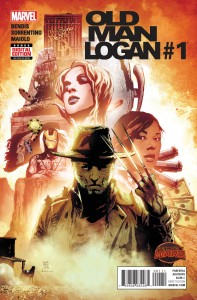 landscape and are menaced by giant mutated insects; it’s a decent-enough apocalypse-survivor tale that ends up with a not-seen-before Nova Corps character, a couple of Infinity gems and, of course, Thanos. Inhumans focuses on the Attilan section of Battleworld, where Medusa is Doom’s appointed supervisor; it’s really about a group of freedom fighters who contest her, and Doom’s rule, and ends in a resistance-fighter-frequented bar whose bartender is… well, you’ll have to look and see, although you might have to Google his name if you aren’t up on your Marvel history. M.O.D.O.K. is about that big-headed assassin, policing a realm ruled by Baron Mordo and Clea, and has a nice Deadpool-like insouciance about all of its violence and a
landscape and are menaced by giant mutated insects; it’s a decent-enough apocalypse-survivor tale that ends up with a not-seen-before Nova Corps character, a couple of Infinity gems and, of course, Thanos. Inhumans focuses on the Attilan section of Battleworld, where Medusa is Doom’s appointed supervisor; it’s really about a group of freedom fighters who contest her, and Doom’s rule, and ends in a resistance-fighter-frequented bar whose bartender is… well, you’ll have to look and see, although you might have to Google his name if you aren’t up on your Marvel history. M.O.D.O.K. is about that big-headed assassin, policing a realm ruled by Baron Mordo and Clea, and has a nice Deadpool-like insouciance about all of its violence and a  couple of interesting guest-stars; the art’s OK, but the cover, by David Lafuente, is so cool-looking that I’d like to have seen the whole book by him instead. Old Man Logan is from the world of that popular Mark Millar series, where an older Wolverine wanders through a desolate America where most of the other superheroes died a generation earlier, and is enlivened by the Brian Michael Bendis script and the suitably-shadowy, painterly Sorrentino art. Secret Wars:2099 is just what you think it is, looking at a New York City from that era, inhabited by most of the 2099 characters; it’s written by Peter David, who’s been writing Spider-Man 2099 pretty much forever, and it’s a typical
couple of interesting guest-stars; the art’s OK, but the cover, by David Lafuente, is so cool-looking that I’d like to have seen the whole book by him instead. Old Man Logan is from the world of that popular Mark Millar series, where an older Wolverine wanders through a desolate America where most of the other superheroes died a generation earlier, and is enlivened by the Brian Michael Bendis script and the suitably-shadowy, painterly Sorrentino art. Secret Wars:2099 is just what you think it is, looking at a New York City from that era, inhabited by most of the 2099 characters; it’s written by Peter David, who’s been writing Spider-Man 2099 pretty much forever, and it’s a typical 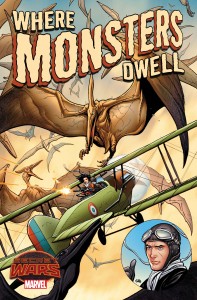 David script, with a clear structure, lots of continuity bits for fans, and humor to leaven the serious parts. Finally, Where Monsters Dwell is by, of all people, Garth Ennis, revisiting his WW I-era Phantom Eagle mini-series from a few years ago, with that character and his biplane hopscotching around the Battleworld equivalent of the South Seas, getting into trouble and eventually running into the prehistoric monsters of the title. Ennis and artist Braun were teamed for a number of years on the semi-satiric superhero spoof The Boys, and they’re quite good at the kind of lighthearted, Indiana Jones-type adventure romp they’re providing here.
David script, with a clear structure, lots of continuity bits for fans, and humor to leaven the serious parts. Finally, Where Monsters Dwell is by, of all people, Garth Ennis, revisiting his WW I-era Phantom Eagle mini-series from a few years ago, with that character and his biplane hopscotching around the Battleworld equivalent of the South Seas, getting into trouble and eventually running into the prehistoric monsters of the title. Ennis and artist Braun were teamed for a number of years on the semi-satiric superhero spoof The Boys, and they’re quite good at the kind of lighthearted, Indiana Jones-type adventure romp they’re providing here.
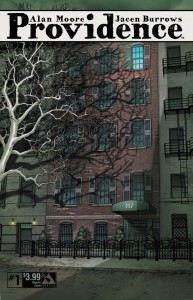 Providence #1 — Writer: Alan Moore; Art: Jacen Burrows; Colors: Juan Rodriguez
Providence #1 — Writer: Alan Moore; Art: Jacen Burrows; Colors: Juan Rodriguez
Fight Club 2 #1 — Writer: Chuck Palahniuk; Art: Cameron Stewart; Colors: Dave Stewart
Material #1 — Writer: Ales Kot; Art/Color: Will Tempest
Sons of the Devil #1 — Writer: Brian Buccellato; Art/Colors: Toni Infante
These are the week’s first issues, and although they’re by vastly different writers they have an interesting similarity: they’re all mysteries, withholding major information about their characters and plots from readers, doling out enough bits and hints to be intriguing but otherwise holding back, guarding their secrets and biding their time. This kind of thing can backfire badly when the writers are making it up as they go along (see: Twin Peaks, 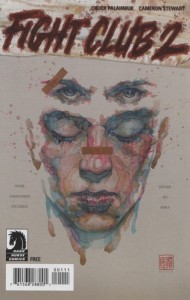 Lost, etc.), but all four writers here seem to be better world-builders than that, with careful, elaborate plans already in place; they know what they’re doing, even if we don’t yet. Moore is an old hand at this, and Providence has him in H. P. Lovecraft territory — the title refers to the Rhode Island town, in the early 1900s (the 19th Amendment is being discussed, but hasn’t passed yet, so it’s around 1919) — but we start out in New York City, as a reporter interviews a mysterious scientist whose room is kept very cold, and there’s talk of a number of local suicides. That cold room and scientist are a reference to Lovecraft’s short story “Cool Air,” and there are number of other submerged hints too, with namedropping of many other Lovecraft real-life associates or story characters. Other secrets lurk, too: the reporter himself has a lover who’s just committed suicide, and wasn’t quite what a surface reading of the book suggests, given a number of subtle clues; overall, there’s that feeling common to Moore stories, where he seems to be laying bricks very carefully, just so, that will pay off in
Lost, etc.), but all four writers here seem to be better world-builders than that, with careful, elaborate plans already in place; they know what they’re doing, even if we don’t yet. Moore is an old hand at this, and Providence has him in H. P. Lovecraft territory — the title refers to the Rhode Island town, in the early 1900s (the 19th Amendment is being discussed, but hasn’t passed yet, so it’s around 1919) — but we start out in New York City, as a reporter interviews a mysterious scientist whose room is kept very cold, and there’s talk of a number of local suicides. That cold room and scientist are a reference to Lovecraft’s short story “Cool Air,” and there are number of other submerged hints too, with namedropping of many other Lovecraft real-life associates or story characters. Other secrets lurk, too: the reporter himself has a lover who’s just committed suicide, and wasn’t quite what a surface reading of the book suggests, given a number of subtle clues; overall, there’s that feeling common to Moore stories, where he seems to be laying bricks very carefully, just so, that will pay off in 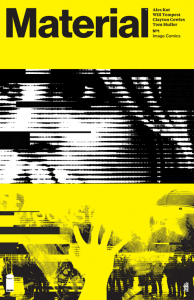 horror or revelation somewhere down the road. Burrows, who last worked with him on Neonomicon, has a basic, transparent style that’s effective at communicating the mood of growing unease. Fight Club 2 is worth noting because it’s an actual sequel to the novel, by Palahniuk himself. Palahninuk is one of those writers whom I feel like I should like, but I’ve never been able to get into him; I read a few pages of one of his books and then put it down and wander off, uninterested (the same thing happens when I try to read Clive Barker). Here, at least, the modern, slightly mangafied Cameron Stewart art keeps my attention, but having never read the original story I have no idea what’s going on, except that some normally-mousy guy seems to be possessed by someone else (the guy from the original book? Or is it just a split-personality thing?) and there’s a big explosion at the end. As with Barker, there are a lot of good little bits, and if you’re one of the many fans of the first book, or movie, you’ll want to read this. Material is Ales Kot in full opaque mode, but with
horror or revelation somewhere down the road. Burrows, who last worked with him on Neonomicon, has a basic, transparent style that’s effective at communicating the mood of growing unease. Fight Club 2 is worth noting because it’s an actual sequel to the novel, by Palahniuk himself. Palahninuk is one of those writers whom I feel like I should like, but I’ve never been able to get into him; I read a few pages of one of his books and then put it down and wander off, uninterested (the same thing happens when I try to read Clive Barker). Here, at least, the modern, slightly mangafied Cameron Stewart art keeps my attention, but having never read the original story I have no idea what’s going on, except that some normally-mousy guy seems to be possessed by someone else (the guy from the original book? Or is it just a split-personality thing?) and there’s a big explosion at the end. As with Barker, there are a lot of good little bits, and if you’re one of the many fans of the first book, or movie, you’ll want to read this. Material is Ales Kot in full opaque mode, but with 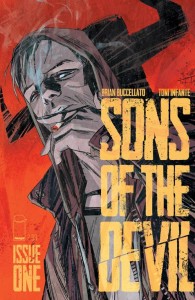 him it’s an attraction (as in, say, his earlier Change, a hallucinatory, gonzo Lovecraftian romp), with a number of different focus characters — an older professor researching the effects of technology, a drug-addled, insecure actress, the experimental director who sees her as his muse, a Chicago civil-rights protestor kid who gets roughed up by the cops, and an Iranian-American who was imprisoned in Guantanamo unjustly, and whose head is all messed up as a result — all somehow connected with the birth of an artificial computer intelligence. The art mostly uses a nine-panel grid, ala Watchmen, and Tempest’s clear line and effective use of colors make it visually attractive. Sons of the Devil suggests its topic in its title, as a guy who grew up as an orphan, with one red and one blue eye, has his unknown past begin to catch up with him; whether his father is a literal, Omen-style “devil” or just a metaphoric one remains to be revealed. Infante’s another artist with a lot of manga influences, especially in her camera angles and foreground/background compositions, and has a smooth storytelling style that makes this a quick, clear read.
him it’s an attraction (as in, say, his earlier Change, a hallucinatory, gonzo Lovecraftian romp), with a number of different focus characters — an older professor researching the effects of technology, a drug-addled, insecure actress, the experimental director who sees her as his muse, a Chicago civil-rights protestor kid who gets roughed up by the cops, and an Iranian-American who was imprisoned in Guantanamo unjustly, and whose head is all messed up as a result — all somehow connected with the birth of an artificial computer intelligence. The art mostly uses a nine-panel grid, ala Watchmen, and Tempest’s clear line and effective use of colors make it visually attractive. Sons of the Devil suggests its topic in its title, as a guy who grew up as an orphan, with one red and one blue eye, has his unknown past begin to catch up with him; whether his father is a literal, Omen-style “devil” or just a metaphoric one remains to be revealed. Infante’s another artist with a lot of manga influences, especially in her camera angles and foreground/background compositions, and has a smooth storytelling style that makes this a quick, clear read.
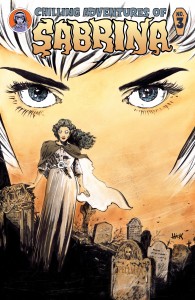 Chilling Adventures of Sabrina #3 — Writer: Roberto Aguirre-Sacasa; Art/Colors: Robert Hack
Chilling Adventures of Sabrina #3 — Writer: Roberto Aguirre-Sacasa; Art/Colors: Robert Hack
Outcast #9 — Writer: Robert Kirkman; Art: Paul Azaceta; Colors: Elizabeth Breitweiser
Deadly Class #13 — Writer: Rick Remender; Art: Wes Craig; Colors: Lee Loughridge
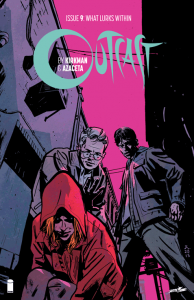 Ragnarok #5 — Writer/Artist: Walt Simonson; Colors: Laura Martin
Ragnarok #5 — Writer/Artist: Walt Simonson; Colors: Laura Martin
The rest of the week’s offerings: Sabrina continues to be a surprisingly-effective horror book, set in a parallel universe where the Archie characters are more realistic and less cartoony, and the witchcraft of Sabrina and her aunts is extended to its logical, occult conclusion; Hack’s other- worldly art and coloring give it just the right dreamlike, lurking-dread tone. Azaceta does some of the same over in the exorcism/possession book Outcast, wringing suspense from the smallest of gestures or shadows, as Kirkman continues to set up all his plot dominoes and slowly reveal his secrets. Deadly Class, meanwhile, reaches the end of its
worldly art and coloring give it just the right dreamlike, lurking-dread tone. Azaceta does some of the same over in the exorcism/possession book Outcast, wringing suspense from the smallest of gestures or shadows, as Kirkman continues to set up all his plot dominoes and slowly reveal his secrets. Deadly Class, meanwhile, reaches the end of its  first overall arc, with s reverse-twist tragedy and chilling final scene that will stay with readers for a while, thanks to Remender’s smartly-constructed plot and Craig’s evocative art (Loughridge’s coloring adds just the right touch, too), while Ragnarok continues Simonson’s Thor-without-quite-calling-him-that tale, wherein the mummified Thunder God, having died during the title event, comes back and explores his post-apocalyptic world. When a creator reaches Simonson’s age and experience levels, everything he does is worth a look, and this is no exception.
first overall arc, with s reverse-twist tragedy and chilling final scene that will stay with readers for a while, thanks to Remender’s smartly-constructed plot and Craig’s evocative art (Loughridge’s coloring adds just the right touch, too), while Ragnarok continues Simonson’s Thor-without-quite-calling-him-that tale, wherein the mummified Thunder God, having died during the title event, comes back and explores his post-apocalyptic world. When a creator reaches Simonson’s age and experience levels, everything he does is worth a look, and this is no exception.



